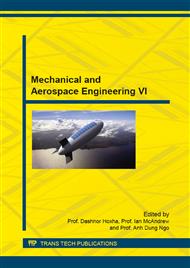p.576
p.582
p.589
p.596
p.602
p.609
p.615
p.622
p.627
Inverse Design Method for a Supersonic Ring Wing Based on the Busemann Concept
Abstract:
In this work, three new types of supersonic ring wings have been developed when cruising at a given angle. The first one is designed by a new variable-section approach based on the Licher concept with the consideration of three dimensional flow effects. The other two are designed by an inverse optimization method, which can modify the discrepancies between the CFD (Computational Fluid Dynamics) results and the linearized theory. A new stair target pressure distribution, as the key of the inverse design method, is developed to overcome drawbacks of the original one by some aerodynamic force analyses. The new ring wings have better aerodynamic performance than the initial one with the largest increment of drag-lift ratio (57.5%) and sustain the advantages at a series angles of attack.
Info:
Periodical:
Pages:
602-608
Citation:
Online since:
October 2015
Authors:
Price:
Сopyright:
© 2015 Trans Tech Publications Ltd. All Rights Reserved
Share:
Citation:


